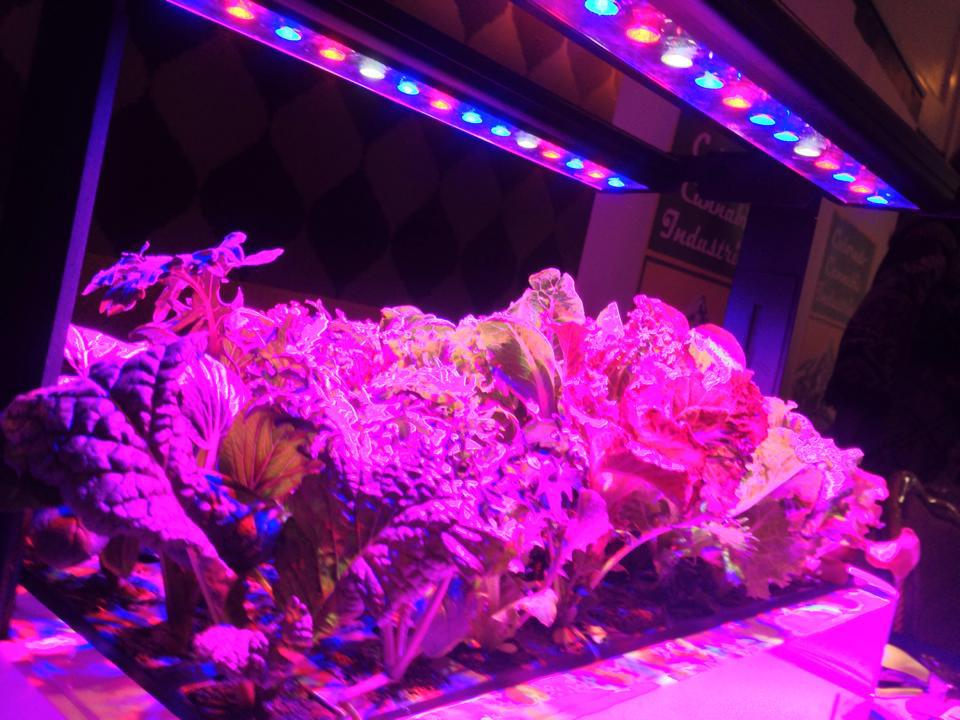Can I use normal led lights to grow plants indoors?
LEDs, being monochromatic sources and being available in wide range of pure colors, are the only light sources that can be tailored to give right spectrum & do wonderful things for plant growth. Plants grow quicker and healthier than under other, traditional lighting methods such as HPS, and if the LEDs are good, then even better than under natural sunlight.
Different color LED chips placed inside the light, give different kind of response from plants. It is said that, if we want plants to grow tall, increase the amount of far-red, yellow, orange and green chips inside the luminaire. If we want plants to be compact, put more blue or UV colored chips. It seems, these kinds of responses are encoded in plants’ DNA and when designing LED lamps, we can count on plants responding the way nature has designed them to.

Two essential light colors to be placed in an LED lamp are: red and blue. Red is the main component needed for photosynthesis and stem elongation inhibition. Additionally, it signals to the plants that there are no other plants above it and that it can thus have uninhibited development. Blue stimulates stomatal opening, stem elongation inhibition, leaf expansion, curvature towards light and photoperiodic flowering. The combination of these two sets of effects will, in simple terms, get the plant from seed to the vegetative stage and eventually to flowering, but much slower than under continuous spectra a.k.a spectra that contain more than just red and blue. Adding some other spectrum colors such as green, could enhance the leaf expansion rate and stem elongation, which in turn results in higher biomass (yield) accumulation. Adding UV wavelenghts affects the accumulation of compounds such as phenolics which could boost the flavor of the end product or its health benefits to humans.
Red and Blue LED chips are the cheapest to procure. And this is why most LED grow light manufacturers opt for simple red-blue combinations.
With a set of grow lights, you can grow many plants indoors, including houseplants, orchids, and even some fruit and vegetable crops. Grow lights are ideal for seed starting because they help ensure stocky, green seedlings. A wintertime harvest of herbs and salad greens can also be grown under lights. By learning how plants use light and about the fixture options, you can select an indoor grow lights system that is right for the plants you want to grow.
The Right Color
Sunlight contains the complete spectrum of light including all colors of the rainbow: red through yellow to blue and violet. Like plants growing outdoors in the sunlight, indoor plants grow best under full-spectrum bulbs, which produce a balance of cool and warm light that replicates the natural solar spectrum. They’re excellent for seedlings as well as houseplants, culinary herbs and other plants.
The Right Intensity
The intensity of light that a plant receives is determined by the brightness of the bulb and by how close the plant is to the light source. Plants differ in their need for light intensity. Typically, those plants that are native to tropical jungles or shady forests do not require as much light as plants that evolved in dry, sunny climates, such as the Mediterranean or southern Mexico.
Some flowering houseplants, such as African violets and begonias, are happy being 10 to 12 inches away from a light source. Foliage plants, such as ivy or philodendron, can be placed as much as 36 inches away from a light source. But many flowering plants, such as orchids, gardenias and citrus, as well as most vegetable plants, require a much higher light intensity to flower and produce fruit.
The Right Duration
No matter what types of plants you are growing, you must give them a rest. When it’s dark, plants respirate, which is an important part of their growth process. The balance of rest time to active growth time affects many biological processes, including the growth rate, and the setting of buds and fruit.
Vegetable seedlings need 14-18 hours of light a day.
Botanists usually divide plants into three categories relating to their preferred day length: short-day, long-day or day-neutral.
Short-day plants, such as chrysanthemums, kalanchoe, azaleas and begonias, will thrive on less than 12 hours of light per day. In fact, these plants must usually go through a series of even shorter days before they will set buds and flower.
Long-day plants require 14 to 18 hours of light each day. Most seedlings for vegetables and garden flowers are long-day plants. When they don’t receive enough light they get pale and leggy.
Day-neutral plants, including foliage plants, geraniums, coleus and African violets, are usually satisfied with 8 to 12 hours of light all year-round.
